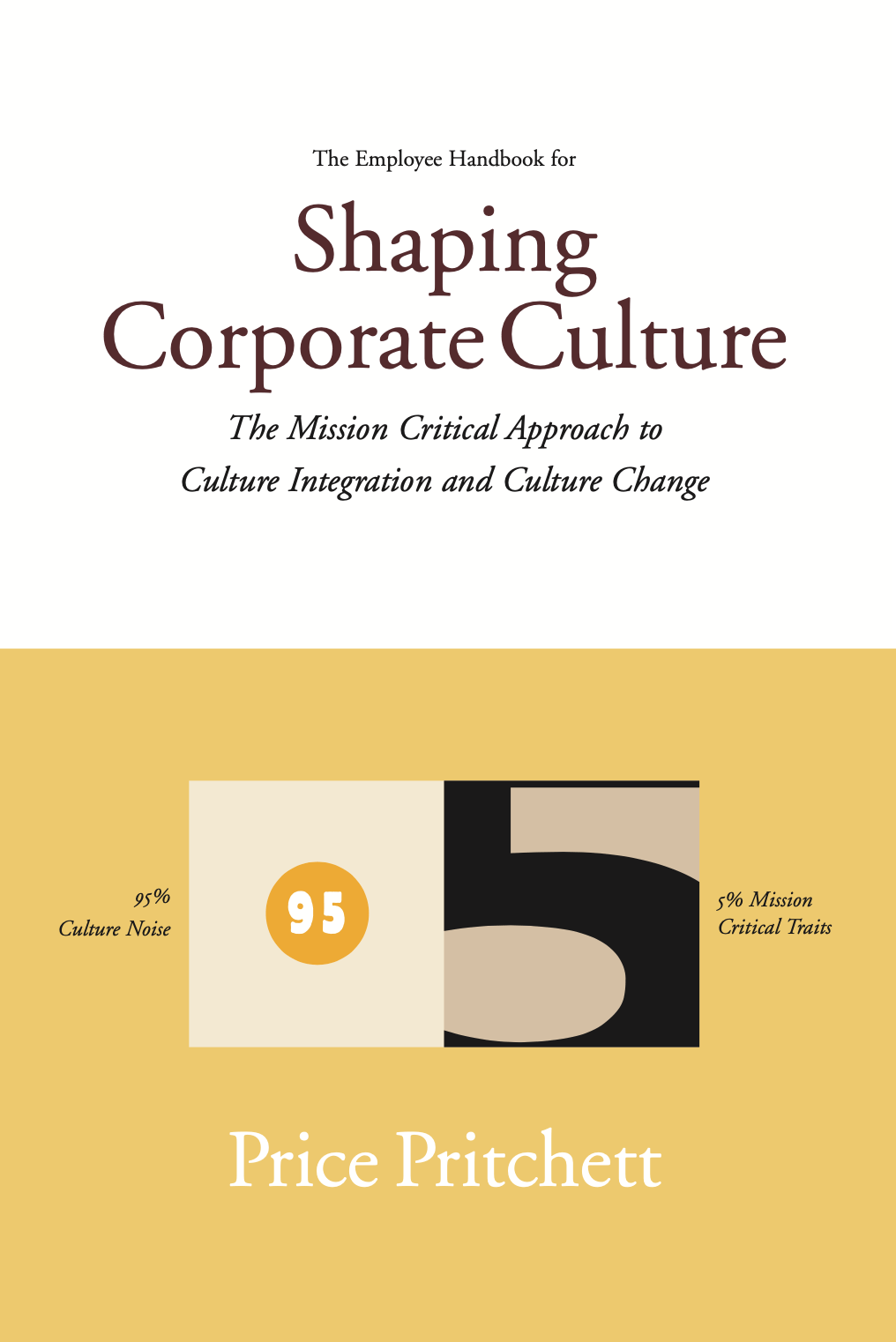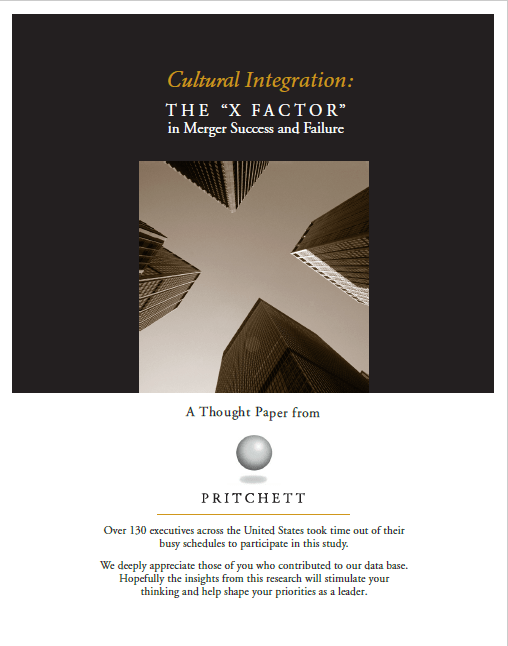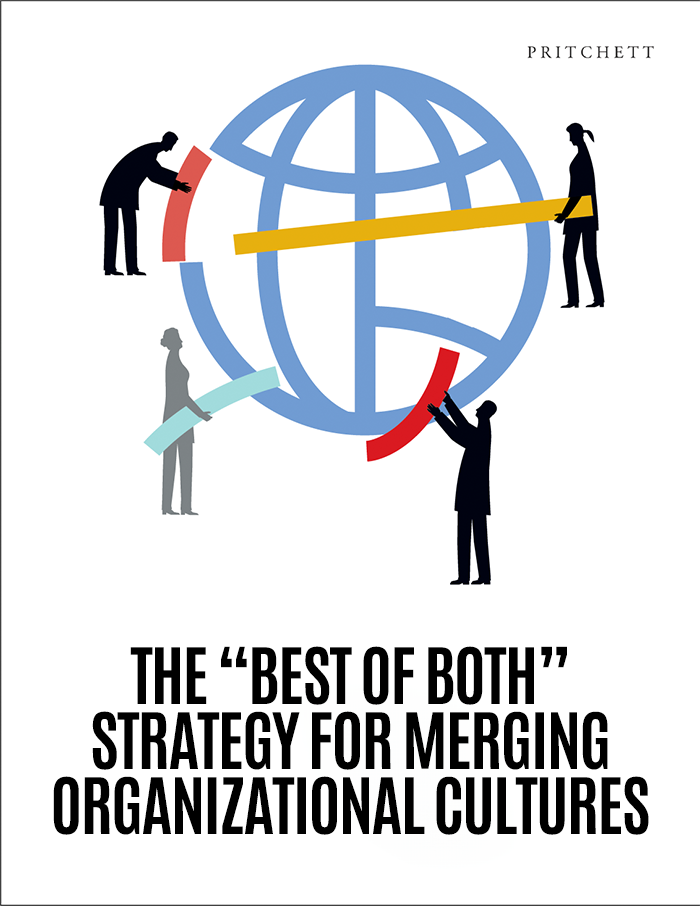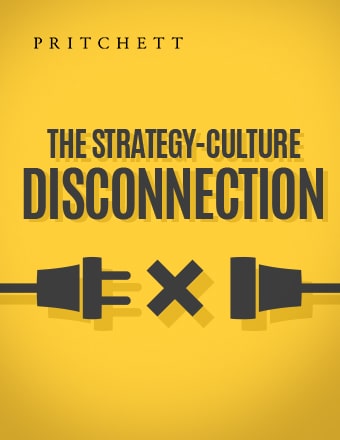Answers to Post-Merger FAQS on:
Best Practices
Communication
Day 1
M&A Integration Teams
M&A Integration Plans
Acquisition Integration
Risks
Managing People
Post-Merger Exam
Based on Answers to FAQs
How should you handle cultural differences during post-merger integration?
Quickly determine the key cultural differences between the specific parts of the two organizations that you, personally, are responsible for helping to merge. Make this a fast, localized evaluation—a side-by-side departmental comparison, for example—not a comprehensive, cross-company study that drags on for months. Get help with this if you need to, just don’t let it become a long, drawn-out exercise. Get it done early on.
Then, communicate to your people what the key differences are. Be up-front. Talk in specifics. Take pains to ensure that they follow what you’re saying. Next, state clearly any changes that will be made going forward. And explain why you’re making these culture shifts. Basically, what this simple management act comes down to is this: You’re helping them “break the code” quickly, rather than leaving them to wander along for months or years wondering what the prevailing cultural bylaws will be.
What is organizational culture? And what is cultural integration in M&A?
Organizational culture is broad and deep. Very complex. It covers almost everything regarding how the organization lives, works, and thinks about the world in general.
Some aspects of culture are in plain view—such as how people dress, their daily routines, the way the company treats customers and suppliers and the employees themselves. Then there’s the invisible stuff like beliefs and values, or assumptions about the best way to run a business.
Cultural integration in M&A is the process of identifying the gaps between the two merging cultures, determining which gaps should be closed, and then deciding how to close them. Since corporate culture is deep rooted and extraordinarily difficult to change, cultural integration is almost always a difficult exercise.
Should you try to build one common culture during an integration?
No. A few shared values... a couple of operating principles common to all parts of the new merged organization... a small handful of company-wide standards. That’s okay. That makes sense. That much you can get across to everybody and try to uphold or enforce during an integration. Beyond that, you should manage the merger toward corporate culture diversity. Toward peaceful coexistence of the many tribes—different people, working in different ways, converging on common goals...not conforming to a pervasive corporate culture. That’s reality-based management. You can actually pull that off successfully. And that cultural mix positions you best to beat the pants off the competition.
Do most acquirers perform formal cultural assessments on target companies?
No. In fact, only a mere 4% of the executives surveyed in a PRITCHETT study indicated their organizations include culture-specific questions in their due diligence checklists. Similarly, only 5% of the respondents say they conduct a “culture gap analysis” or compatibility study using a structured survey form to determine cultural fit. There seems to be a lot more talk than action on the culture front. Executives pay lip service to the importance of culture in mergers, but they routinely fail to back it up with dollars. Culture is the pauper when integration budgets are allocated. Due diligence should scrutinize cultural aspects of the deal with the same discipline given to financial and legal issues.
What are questions you could ask when performing a cultural assessment of the acquired company?
- How do people feel here about being merged/acquired?
- What would be your (or others’) major concerns about being acquired or merged?
- What are the defining characteristics of your company? (What’s distinctive? What differentiates you from other organizations in general? From the competition?)
- Describe the company’s core values. (What does it believe in?)
- What do outsiders not know/realize about this company?
- What are its idiosyncrasies? (What are the most peculiar
- What are the unwritten rules around here?
- What aspects of the culture are most important to people here?
- Where in the organization do the dominant subcultures exist?
- What are the company’s negative or undesirable cultural attributes? (What aspects of the culture need to change?)
- What are the cultural strengths? (What aspects of the culture should be protected/sustained?)
- Is the company getting stronger, weaker, or just holding steady? What trend lines do you see? (What do you feel?)
- What do you see as being key to the future success of this company?
- How does the organization need to change?
- Considering the culture of the acquirer/merger partner, what do you see as the most salient differences? (Where would the friction or flash points be?)
Why do so many M&A culture change initiatives fail?
- Companies often proceed without a clear endgame in mind. For example, culture data is gathered with no viable methodology for how it will be used. No surprise—their initiatives fizzle out.
- Most culture assessment efforts are conducted too late to be of much value. They’re also too ad hoc, unstructured, sketchy, and haphazard. In fact, they may very well cause more problems than they solve. There is a clear lack of efficacy in the data-gathering process and how that information is utilized.
- Companies rely on experts in the deal-making process, but then turn culture integration over to people who lack expertise in managing the intense political dynamics and psychological complexities involved.
- Outside consultants have utterly failed at establishing credibility in this arena. Executives have apparently concluded that the purveyors of traditional culture assessment/culture integration services don’t add value.
Where should culture change initiatives be focused?
Look across merging organizations, and you’ll see all kinds of cultural hot buttons. The challenge is to keep the change effort focused on the 5 percent of culture that’s mission-critical. The two companies can’t afford to get distracted by the multitude of cultural issues that don’t drive the business. These 7 mission-critical areas should be focused on because they can carry enough voltage to impact operating performance:
- Decision-making process
- Spending habits
- Communication practices
- Reward system
- Power and authority
- Work habits
- Organization structure
Does financial success during the integration facilitate culture change?
Should you try to create a new culture by taking the best of the two company cultures?
That sounds good in theory, but it’s a high-risk proposition. It makes about as much sense as a man and woman who marry and announce that they plan to blend their two personalities into one. . . 50-50. . . at the same time that they’re trying to adjust to all the routine stresses and strains of married life. It’s a recipe for failure, whether you’re talking about a marriage or a merger.
Why are culture and strategy so often out of alignment?
Strategy is forward-oriented. It is today’s game plan for tomorrow. Culture, on the other hand, is essentially the product of your history. One is shaped by the future, and the other is forged by the past. Strategy can be re-routed quickly. In fact, that often happens in a company that is being acquired and merged. But culture doesn’t behave that way. Culture fights being changed—that’s its nature.






